Back in November 2022, my sister introduced me to 16:8 intermittent fasting (IF). I started off at a weight of 180 lbs, which ostensibly isn’t too bad for a 6’1” tall man. However, I also had a Dexa body scan confirming I had some excess fat around my midsection and could still improve my body mass index (BMI) and body fat percentage.
Over the next 6 months, I lost about 10 pounds, bottoming out at 170 lbs. Unfortunately, my weight plateaued after I went on a summer vacation and otherwise wasn’t strictly following the 16:8 IF method. I then experimented with some other fasting variations, including one meal a day (OMAD) and 36 hour extended fasts (aka “monk fast”). [1] Although my weight didn’t increase above 175 lbs, it wasn’t progressing towards my 165 lb target weight either.
First a disclaimer: What I’m about to describe is for informational purposes only and you should consult with your physician before embarking on this or any other fasting method. I’m not a doctor or nutritional expert and the results described herein are solely based upon my own personal experience.
Enter Variable Multi-Day Fasting
Since the combination of intermittent and extended fasting wasn’t breaking through my plateau, I decided to ramp up my fasting regimen. I also wanted whatever method(s) I adopted to be optimized around the following 2 goals:
- Make it fit my lifestyle: While I wanted to shed a few more pounds, I didn’t want to sacrifice my lifestyle. For example, I enjoy dining out with friends and family, and my love for pizza, beer, and Mexican food is too strong for me to also adopt a strict diet. [1]
- Steadily and incrementally lose weight: Plain and simple, the goal is to step on the scale each week and see my weight steadily move towards my target weight.
While 16:8 IF provided some initial results, it seemed like the last 10 pounds were the most stubborn to lose. Other fasting methods I’ve considered either (a) don’t guarantee weight loss, or (b) don’t fit my lifestyle; for example:
- Alternate day fasting (ADF): Alternate between days of regular eating and days of fasting or consuming very few calories. This likely would have broken through my plateau but is a bit extreme just to shed a few more pounds.
- 5:2 fasting: Eating normally 5 days a week, but only 400-500 calories the remaining 2 days. I may consider this method for maintenance, but I wasn’t confident it was sufficient to break through my plateau.
Based on the 2 goals above, I formulated what I’m calling variable multi-day fasting (VMDF). Basically, the whole process starts each Monday, then proceeds as follows:
- First thing in the morning, step on the scale and compare current weight to the previous week’s lowest weight.
- Either continue fasting another 24 hours or stop:
- If current weight is more than the previous week’s low:
- Fast for another 24 hours.
- Go back to step 1.
- If current weight is below the previous week’s low weight:
- Take note of the current week’s lowest weight.
- Break the fast.
- Resume a normal eating schedule until next Monday.
- Go back to step 1.
- If current weight is more than the previous week’s low:
Unlike 16:8 IF, OMAD, ADF, 5:2 and other fasting methods with a more fixed and predictable schedule for time-restricted eating or fasting, the key to VMDF is the variable number of fasting days to instead achieve more steady and predictable weight loss.
To further illustrate, here’s a flow diagram to summarize the whole process:
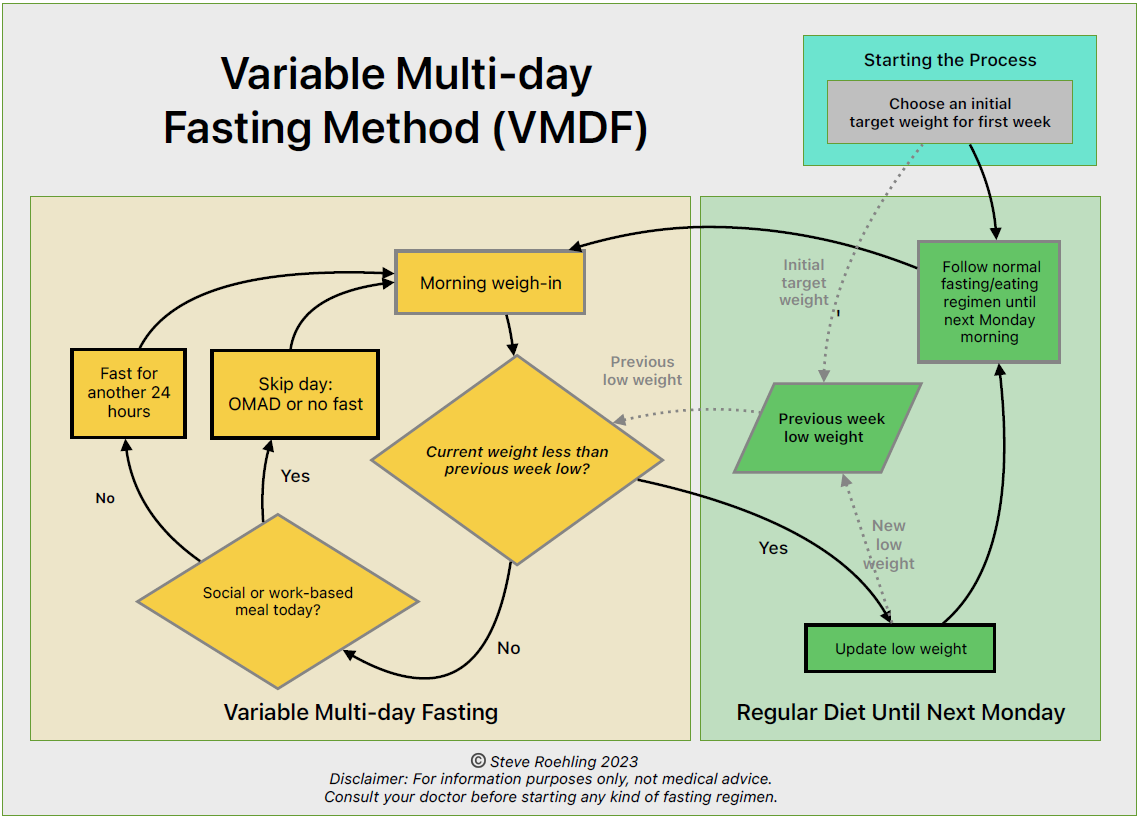
Making VMDF More Flexible and Sustainable
Following the VMDF method for at least 8-12 weeks, including a 36 to 60 hour prolonged fast every week, would have been hard to bear without some leniency and flexibility. The following built-in characteristics of the process itself along with some optional variations helped me stick with the process and fit it into my lifestyle:
- Skip days: When I had a work or social event on a Monday or Tuesday, I wouldn’t fast on these days. I did tend to moderate how much I ate on skip days, hopefully giving me a running start for the next fasting day. Although I never needed more than 2 consecutive fasting days for my weight to drop below the previous week’s lowest weight, I’d also likely add a skip day if my initial fast extended more than 2 days.
- Fasting early in the week: Concentrating prolonged fasting in the first part of the week helped preserve a more social lifestyle for the remainder of the week. Mondays and Tuesdays are typically heavy work days for me, so it’s relatively easy to focus on my work and almost forget about being hungry.
- Dirty fasting: Some people only drink black coffee or water when they fast. I followed a more lenient approach called “dirty fasting”, allowing up to 100 calories of various foods or liquids. For example, I typically added Splenda artificial sweetener to my coffee, along with a splash of almond milk. Throughout the day, I also indulged in diet soda, sugar-free gum, or sugar-free mints. These exceptions definitely made VMDF more tolerable and sustainable.
- Running starts on Sundays: Although the process technically doesn’t start until Monday, I’d often start my prolonged fasting a bit early by making Lunch or an early dinner my last meal on Sunday.
Weight Loss Results
The chart below shows my overall fasting results since I first started 16:8 IF in November 2022; the last few months show my transition into VMDF:
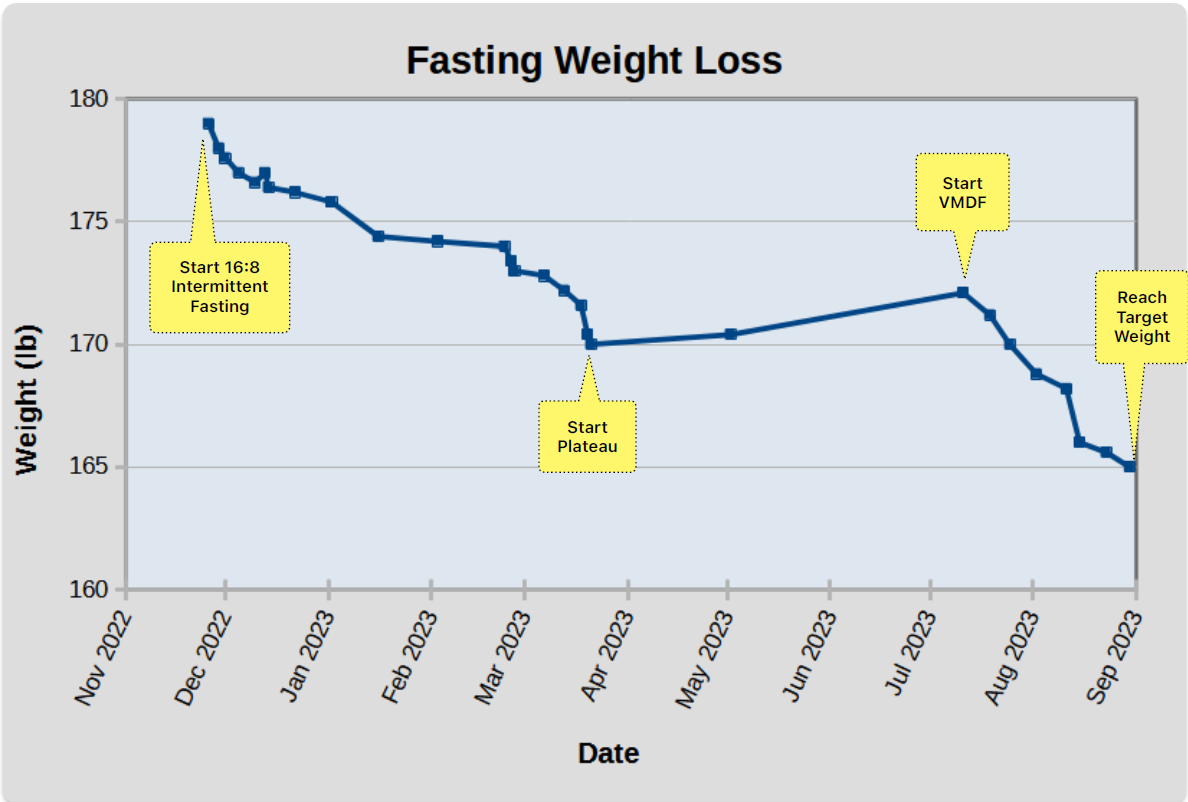
As shown in the chart above, VMDF was definitely effective to break through a plateau and shed the last few pounds to reach my target weight. The following are some more detailed VMDF results:
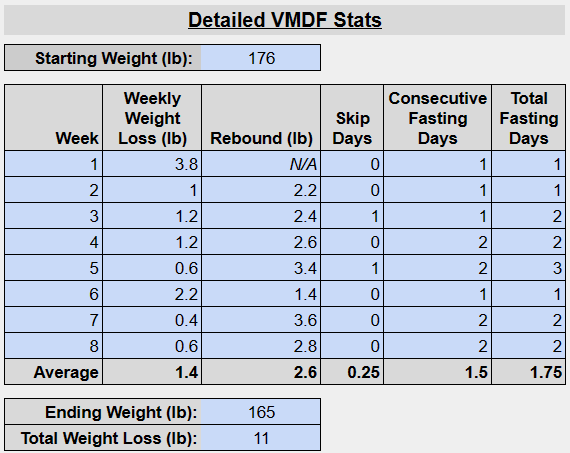
Key Insights and Observations
Experiencing and observing the process first-hand gave me insights into numerous important factors and considerations:
- Effective but not necessarily easy: While the VMDF process itself is relatively simple and effective, fasting for 36 hours or more isn’t easy at first. In my case, I had already done 16:8 IF for over 6 months and had tried OMAD several times; extending OMAD for a few more hours until bedtime wasn’t too hard. Over time, prolonged fasting became more and more tolerable.
- The rebound effect: On average, my weight rebounded 2.6 lbs from the prior week’s low. I had to lose this much weight plus a little bit more each week.
- Moderation when not fasting: When I wasn’t fasting for the remainder of the week, I generally followed my normal 16:8 IF regimen, but otherwise didn’t adhere to a strict diet or intermittent fasting protocol. However, I still tended to moderate my eating, since I didn’t want to make it hard on myself with a large rebound to overcome the following week.
- Hunger was tolerable: It’s counterintuitive, but I was typically less hungry and felt even better on the 2nd consecutive day of fasting than the first. My hunger pangs subsided the longer I fasted and I had plenty of physical energy and mental clarity. I also didn’t feel the urge to binge eat or snack on non-fasting days.
Health Benefits
VMDF primarily focuses on weight loss, but the accompanying health benefits are also a major consideration.
Building on what I’d already experienced with 16:8 IF, I noticed relatively significant cognitive improvements affecting both my short-term and long-term memory, and the degree to which I could “think on my feet”. For example, emails seemed to “roll off my fingertips” and impromptu/extemporaneous verbal communications noticeably improved in business meetings and other conversations. In my line of work managing people and projects, this type of cognitive improvement can be a game-changer.
Along with the skip days and dirty fasting described above, the cognitive improvements I’ve experienced made VMDF more sustainable. Knowing I’d have heightened cognitive function during the fast and some residual positive effects for the rest of the week, I actually looked forward to fasting days.
Based upon my blood glucose and ketone levels, weeks with a 2nd fasting day also put me into a moderate to therapeutic level of ketosis; for example, the following reading was taken 60 hours (2.5 days) into an extended fast:
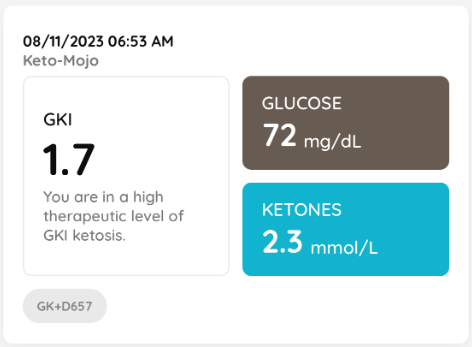
Moderate to therapeutic Glucose Ketone Index (GKI) levels are synonymous with numerous health benefits including improved insulin resistance, reduced inflammation and regenerative anti-aging effects. [2]
Final Thoughts
While achieving the primary weight loss goals, VMDF also proved to be a very balanced and sustainable process. As shown in the illustration below, the overall VMDF process aligned with my work schedule and front-loading the prolonged fasting ensured I could resume a normal schedule and enjoy the remainder of the week:
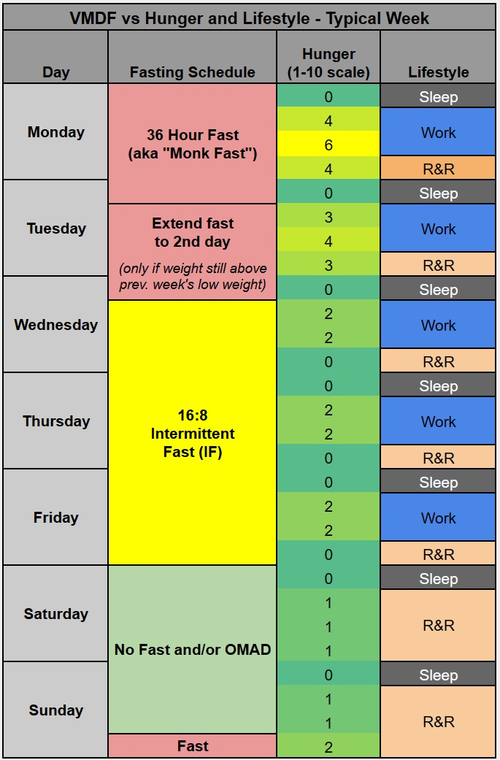
Although I’m not a doctor or nutritional expert, many years of experience as an engineer and system designer have given me a unique perspective to formulate VMDF as a balanced and effective fasting method. When designing a system, engineers think about tradeoffs between fixed versus variable inputs and the effects these have on the outputs (results). In this regard, VMDF trades the more fixed schedule of OMAD, 16:9 IF or other fasting methods for more incremental and predictable weight loss.
Along these lines, I also adhere to the Pareto Principle and focus on a relatively small number of things which are a “win win” and yield the greatest benefit. To this end, following the VMDF process resulted in multiple short-term and longer-term benefits; notably:
- Overcome a weight loss plateau.
- Incremental and relatively predictable weight loss.
- Improved physical appearance through weight loss.
- Improved cognitive function - short and long-term memory, “thinking on my feet”.
- Anti-aging and regenerative effects from autophagy and prolonged fasting.
- It doesn’t cost anything: In fact, my grocery bill went down.
- Spillover effect: At least for me, being a bit more focused and disciplined on one thing tends to boost focus, discipline and self-confidence in other areas of life.
Next Steps
Looking ahead, my primary goal is to maintain a healthy weight while simultaneously improving body recomposition – essentially, swapping fat for lean muscle.
As I’ve transitioned into maintenance, I’m also making a change from my previous approach. Instead of using the previous week’s lowest weight as a target, I’ll now just aim to stay at or below my overall target weight. To provide some additional flexibility and avoid rebounding above my target weight, I’m also planning to shed a few extra pounds. I’m thinking this buffer will allow me to follow a less restrictive fasting regimen like the 5:2 method.
After another month or two focusing on maintenance and body recomposition, I’m also planning to get another Dexa scan and undergo another round of fasting-related blood tests. I’m eager to see these results and gauge my overall progress.
As part of an overall fasting lifestyle to progressively improve one’s appearance and health, different fasting methods can be leveraged at different times. Even though I’ve reached my target weight and have completed VMDF for now, I plan to continue fasting under various other methods. In this context, VMDF has been a valuable part of my journey and I’m more committed than ever to a healthy fasting-based lifestyle.
Footnotes
[1] This is a good video from Dr. Jason Fung about various fasting regimens and the importance of making fasting fit into your lifestyle: What is the Best Fast Length? (Fasting Basics 3)
[2] Information on GKI from my glucose and ketone meter’s website: Glucose Ketone Index [GKI]